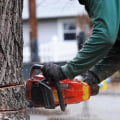The need to remove trees is usually lower during winter and spring, so better tree companies can offer lower rates to ensure a stable business. February and March have been statistically the cheapest months for tree removal, also known as the “dormant season” for trees. Winter is the cheapest time of year to remove a tree. The most affordable time of year to remove a tree is during the slower season, when tree removal companies are less busy.
This means that in the United States, winter and autumn are the best times of the year. Spring and summer are the most expensive times to remove a tree, as most certified arborists usually have full reserves for weeks, if not months. The cheapest time of year for tree removal is winter. Why? Because tree work is slow and tree services need to offer lower prices to get work that will allow them to overcome the colder months.
February and March are usually the cheapest months to remove trees, statistically. Since the leaves have fallen and the trees are easier to clean, it means less work and less money. That said, tree companies can be very busy in late spring. It is important to book as soon as possible, if you know you are coming.
In some cases, it may be cheaper to cut trees in winter. The dormant season is also a good time to prune trees if you want to keep them healthy. December to early March seems to have the lowest tree removal rates of the year. Tree companies are ready to offer reduced prices so they can have a steady flow of business.
Sometimes it is possible to save 25 percent of the price of tree removal when it is done in winter. When it comes to tree removal, planning ahead is a great way to save some money. This is because the cost depends on the season in which you do the work. Any arborist will tell you that winter is the cheapest time of year for tree removal.
During this time, deciduous trees lose their leaves, but this is only one of the reasons. Other factors play their role in reducing cost. The price of removing a tree depends on several factors, such as the health of the tree, its size and location. But just as trees require different care when they grow and thrive, there are a wide variety of factors that influence the decision of when it is time to remove that specific tree.
For example, if a tree poses a risk, has damaged trunks, raised roots or tilts, it is better to remove it immediately. In other words, if your tree suffers any of these damages, it is imperative to call a tree maintenance company and start removing it. So, while deciding to cut down a tree is never easy, removing it at the right time will help make the process smoother. Finally, the location of the tree is important, but more specifically, its ease of access determines whether it is easy to remove or not.
The price of removing a tree depends on several factors, including the size of the tree, the time of year, the health of the tree, ease of access and more. If your tree has a less serious problem, one of the best times to remove them is during the dormant season, between late winter and early spring. When a tree is under power lines, it is not necessarily necessary to remove it, but rather its branches must be cut, since trees under power lines must mature at heights below 25'. But you may find yourself in a situation where you simply can't wait for the cheapest time of year for tree removal.
Again, like anything else, the higher the demand for tree removal services, the more they will cost. Storms with high winds can cause many problems with trees, which can lead to increased demand for tree services immediately following a storm, as many homeowners will need emergency tree trimming or removal services. Now you just don't know when is the best time to remove a tree and some tips for recognizing when a tree should be removed. You may have heard that trees are cheaper to remove in winter or that summer will always be the most expensive time to remove them.
.






